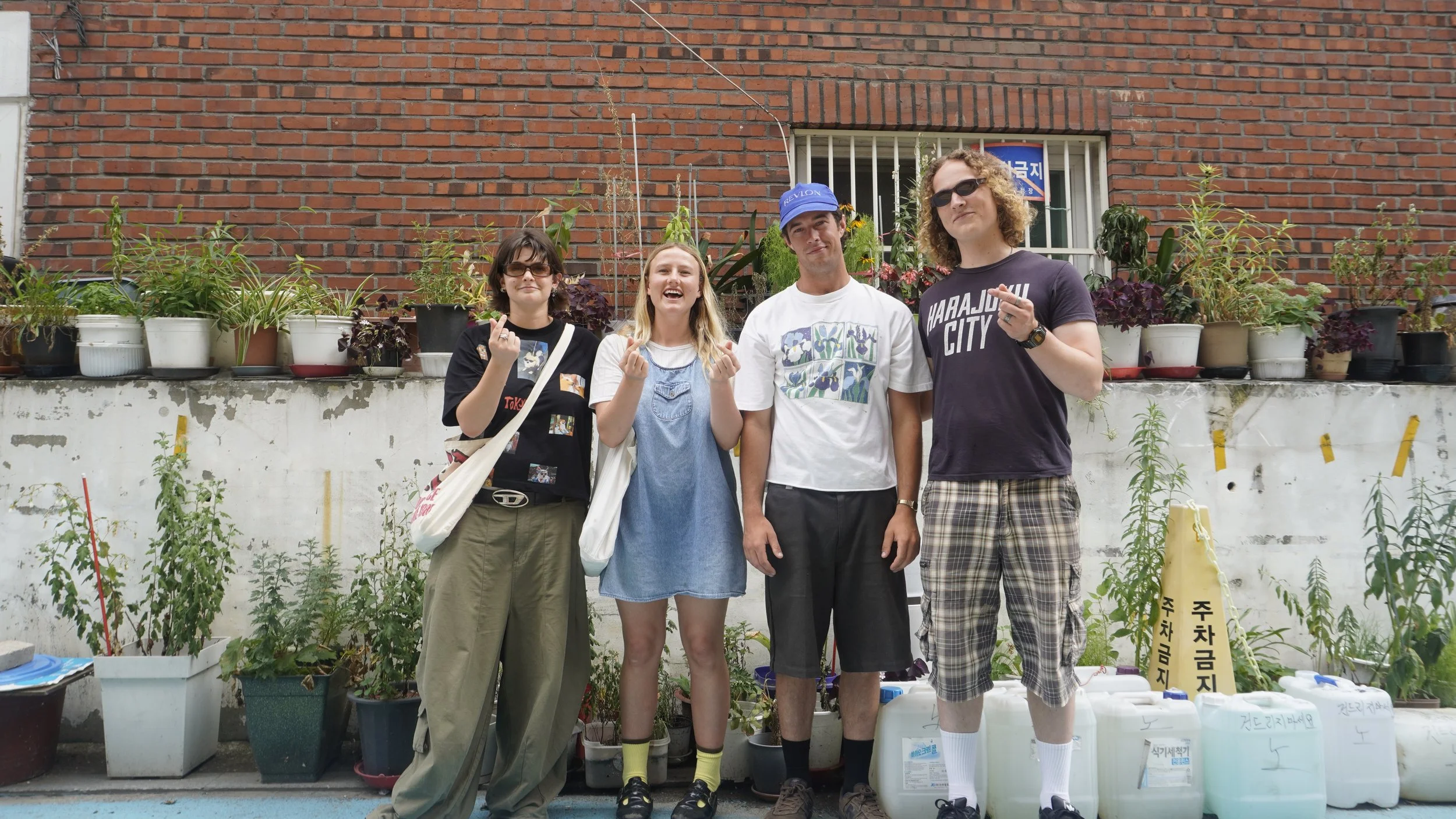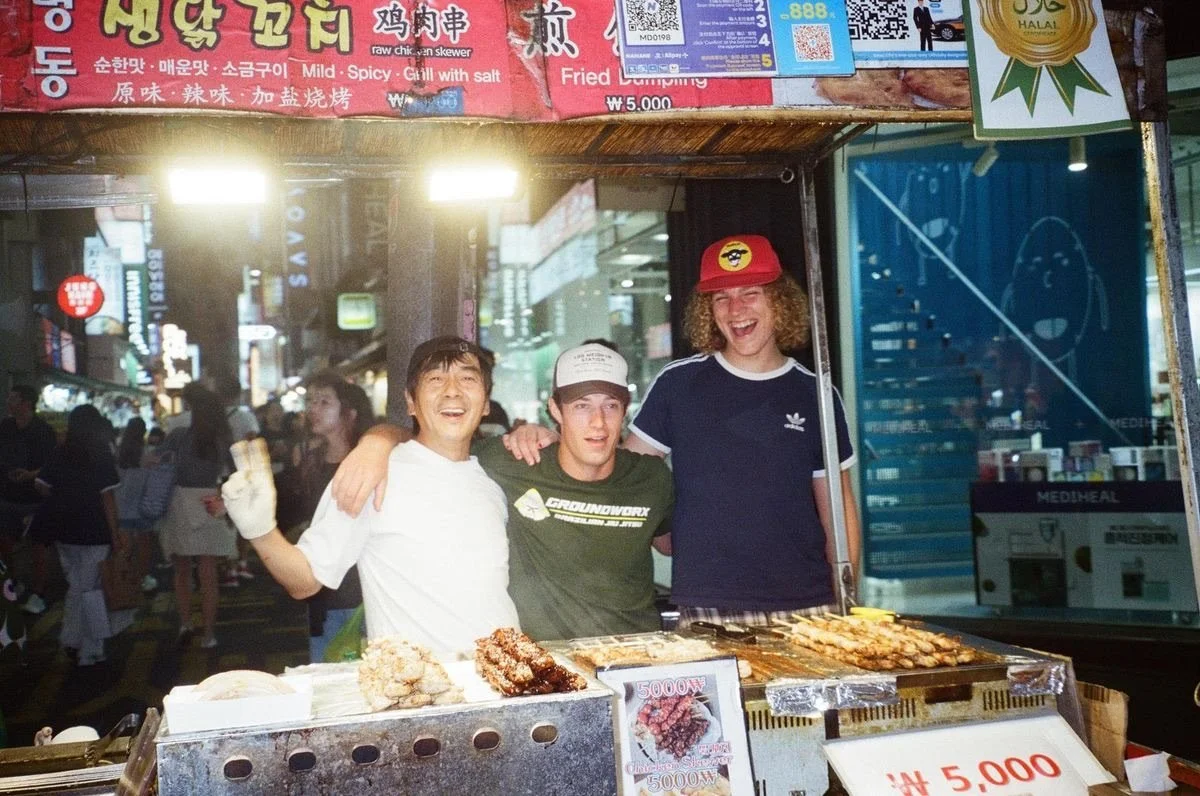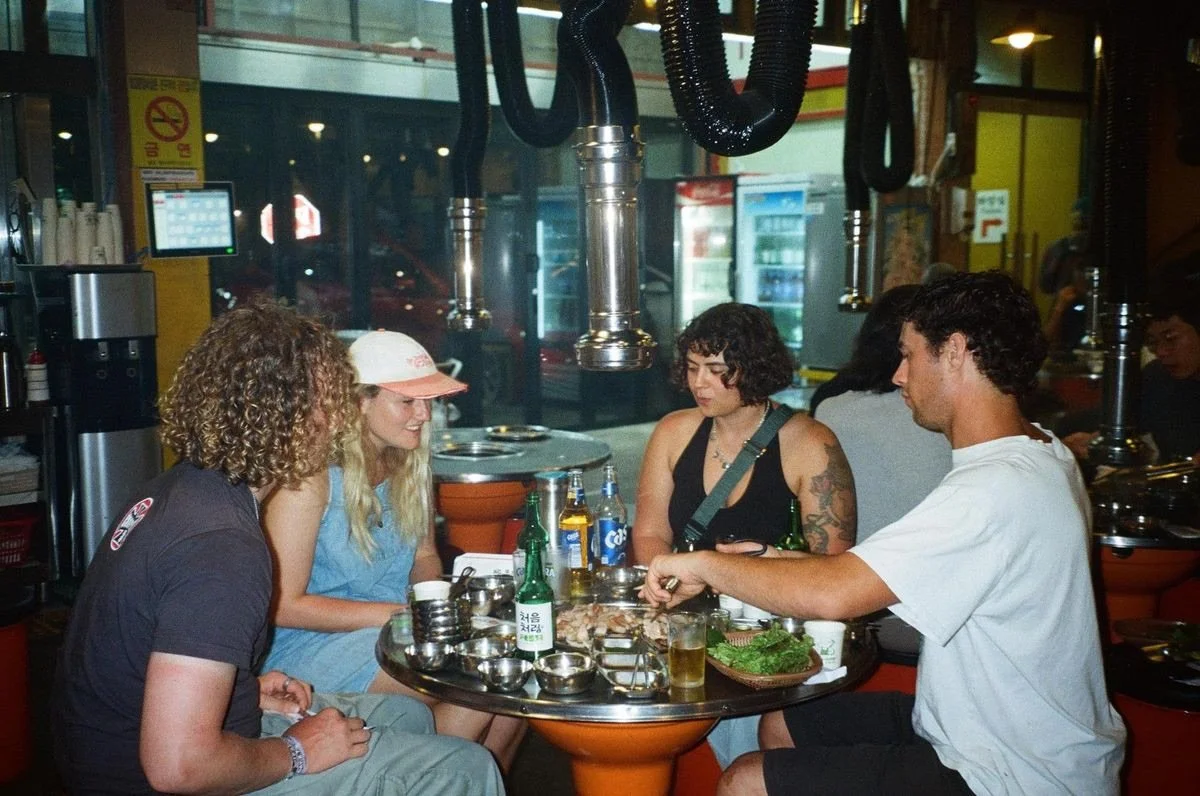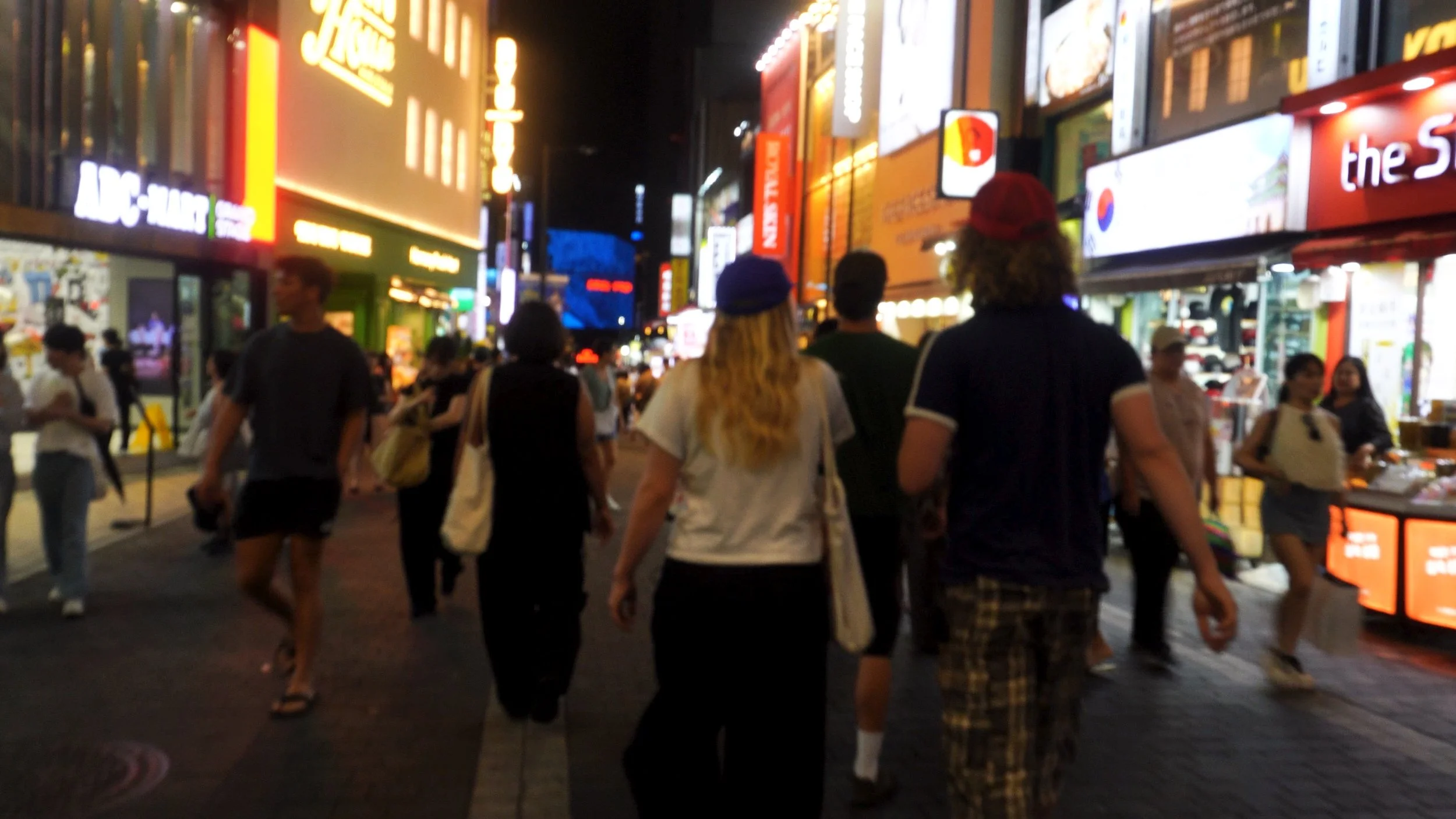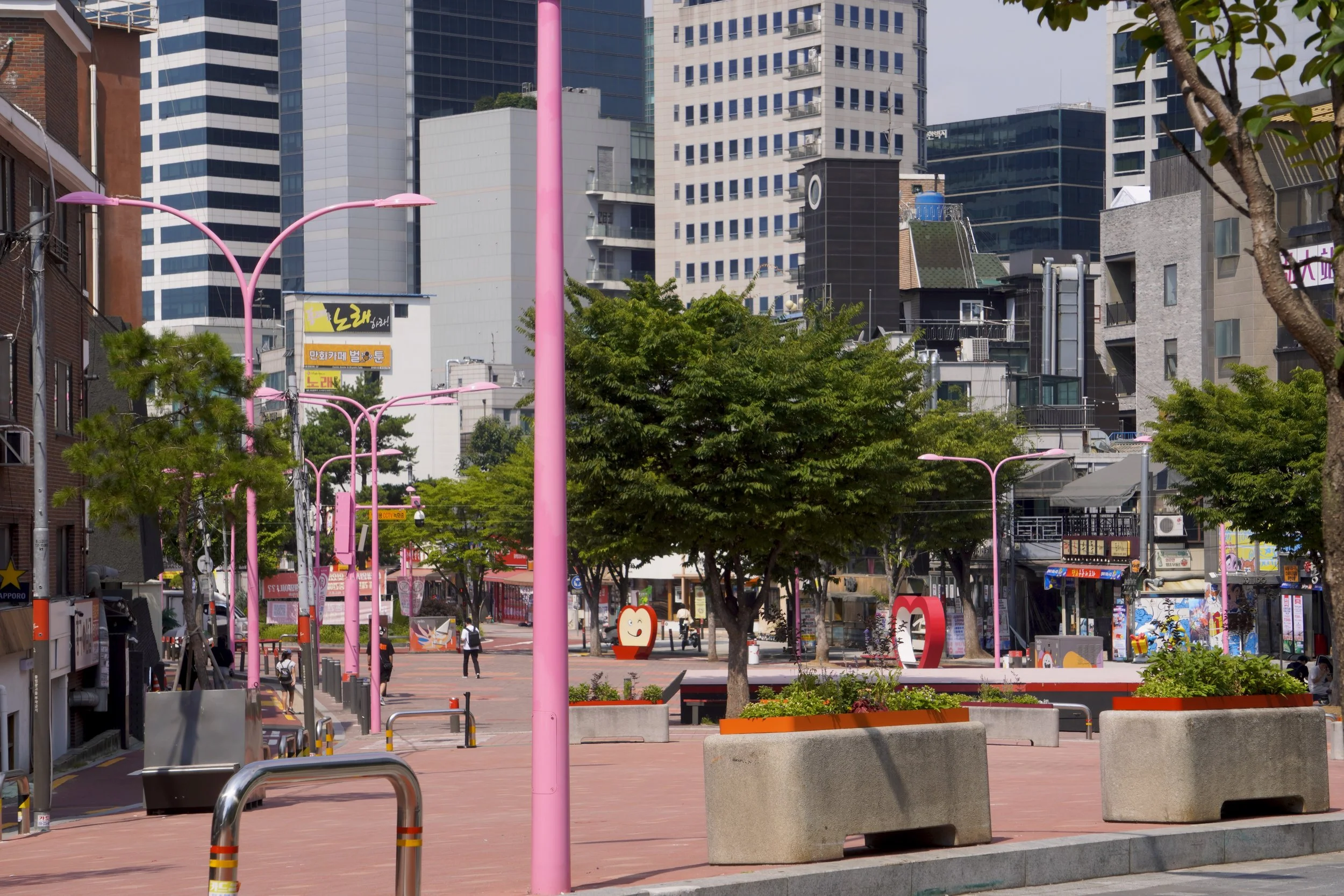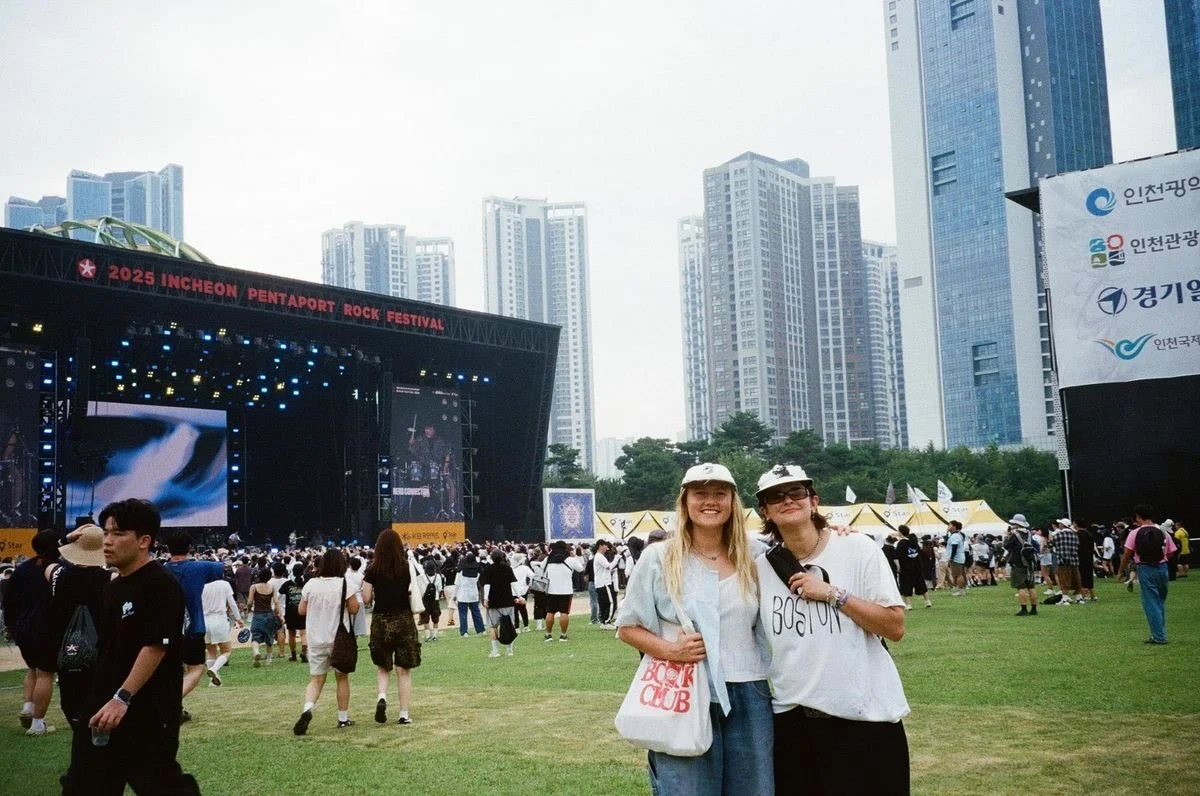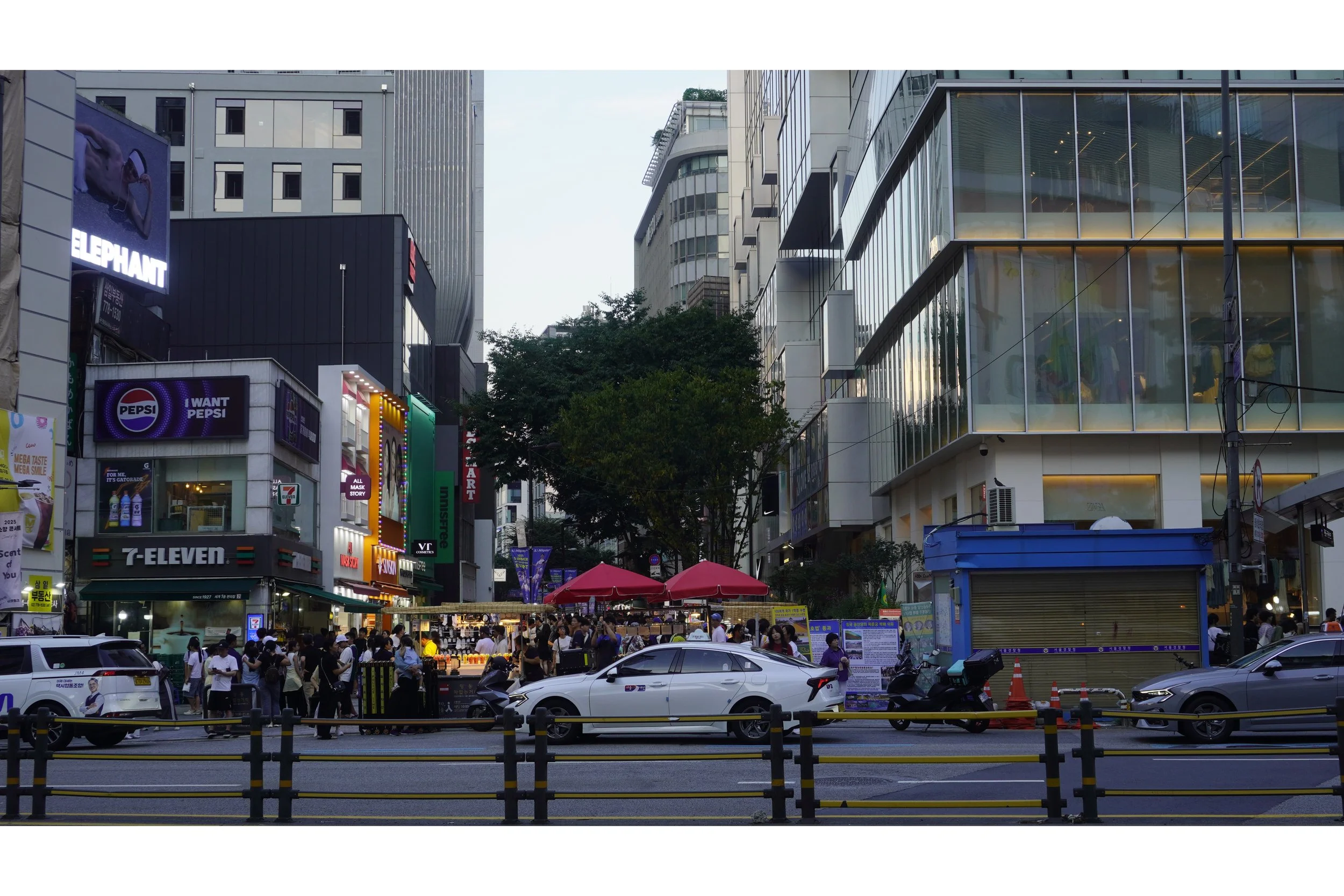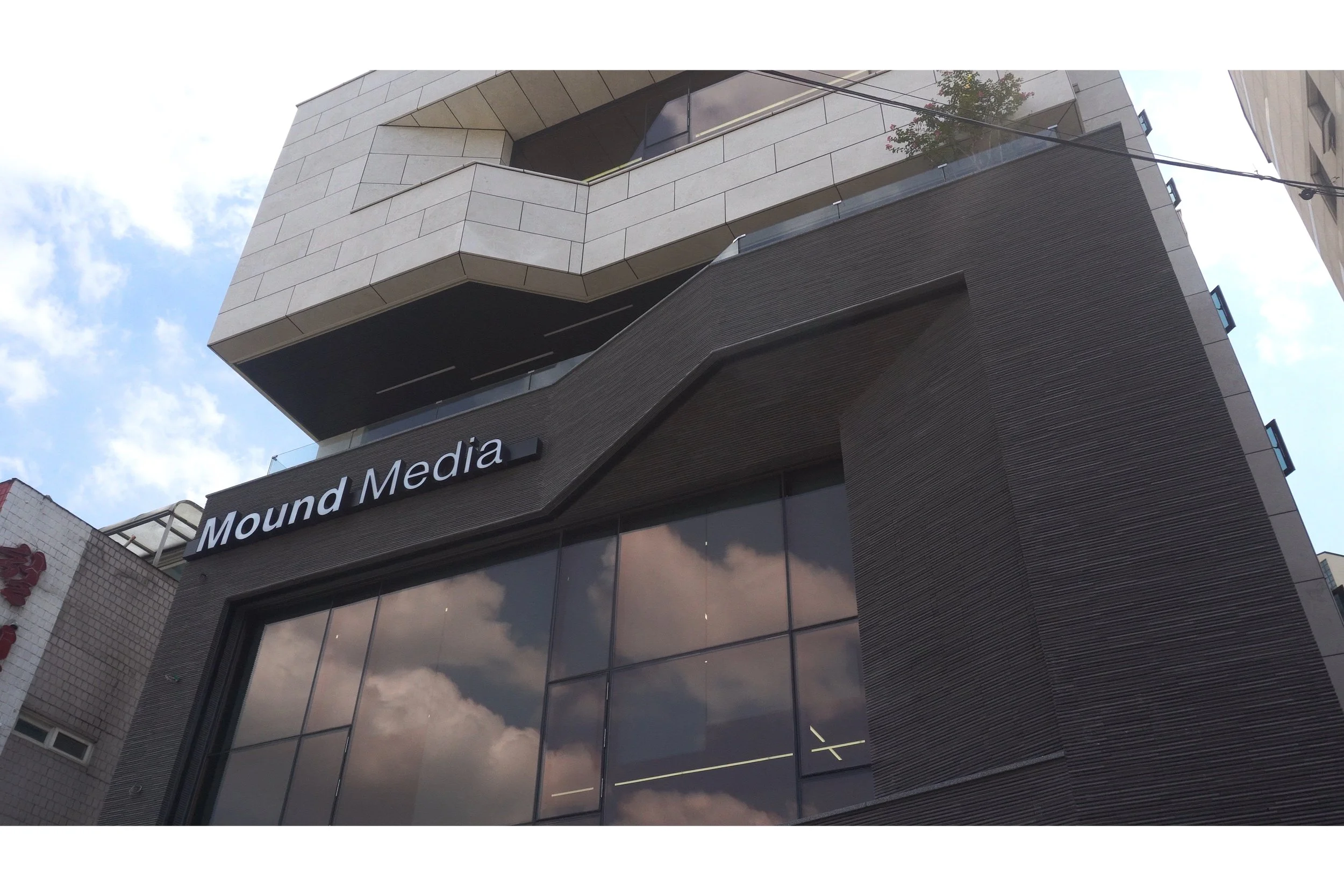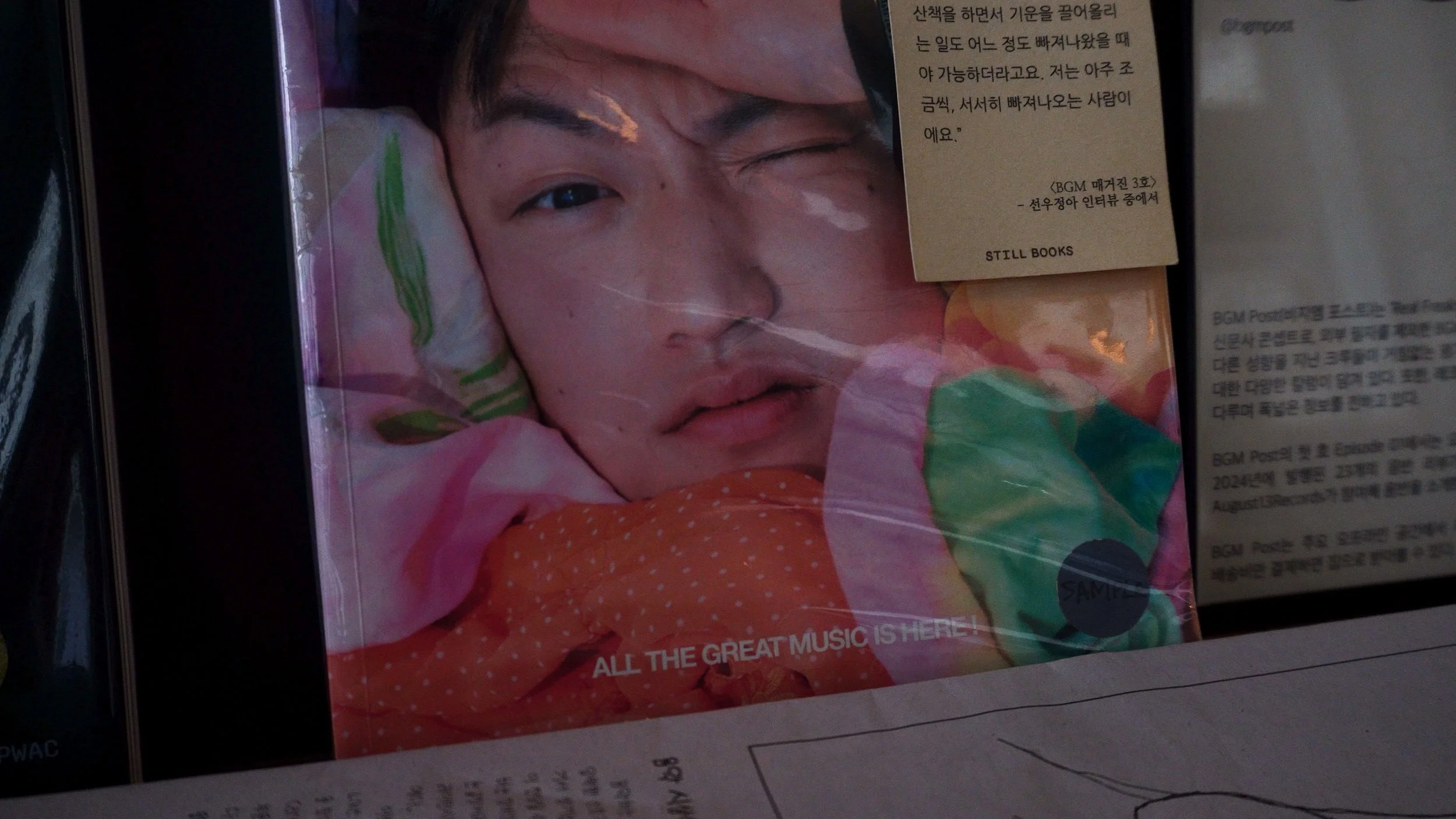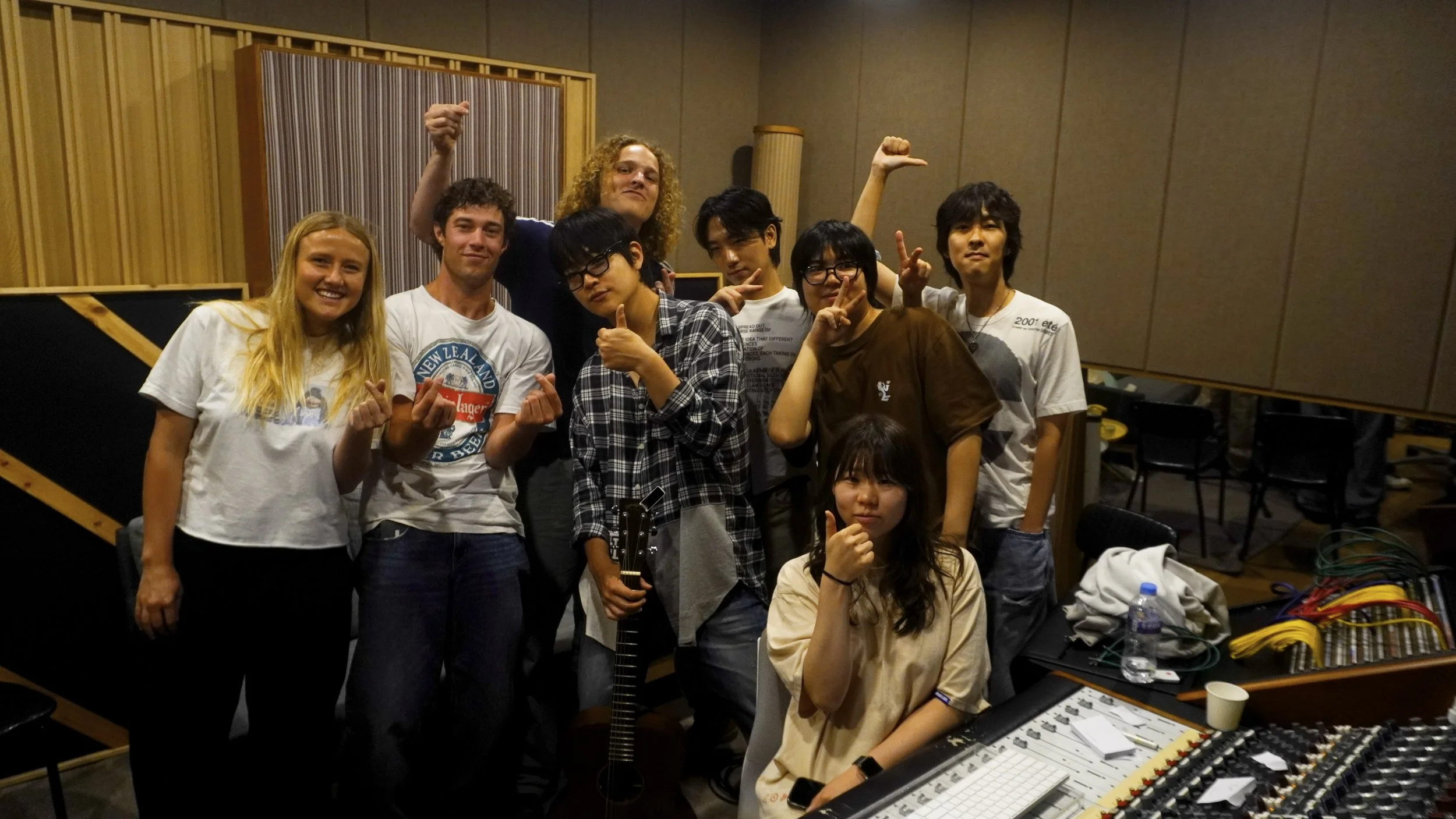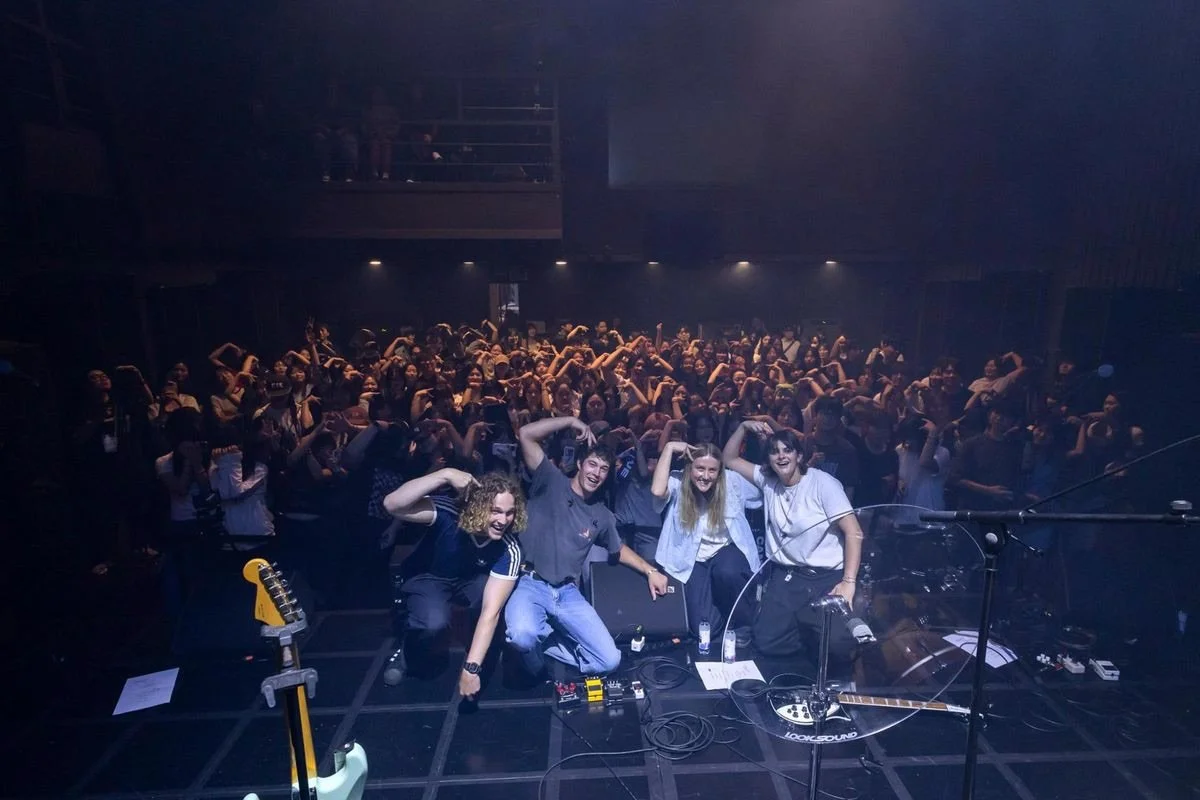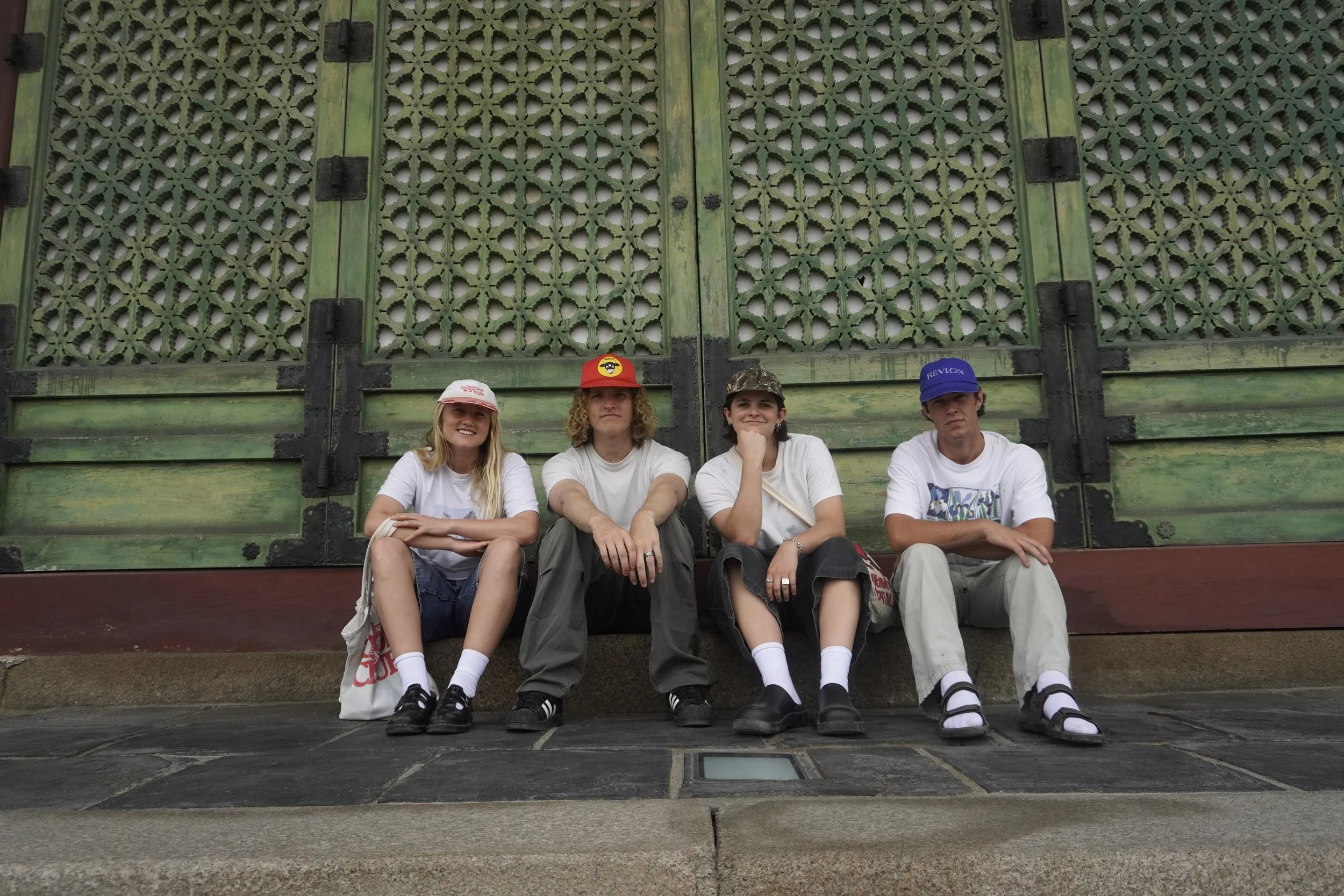There’s A Tuesday Take On Seoul
What business did an Ōtautahi indie band have landing a residency in the land of K-pop? Far more than you might expect. From moshing at a major festival to recording and performing with a K-indie artist, music journalist Samantha Cheong followed the four-piece as they learnt how Kiwi acts can break into the Asian scene—and why South Korea’s appetite for international sounds should never be underestimated.
“Seoul is full of so much aroha,” co-leader Nat Hutton of Christchurch band There’s A Tuesday told the Going Global audience recently.
For the Ōtautahi musicians to describe South Korea using Te Reo Māori shows a profound appreciation for the connections they found there.
Nat and her bandmates—co-leader Minnie Robberds, drummer Gus Murray and bassist Joel Becker—spent ten days in Seoul this August on a residency supported by the Asia New Zealand Foundation, BIG FAN and South Korea’s CJ Cultural Foundation. They were joined by artist manager Cuillin Hearty, BIG FAN general manager Savina Fountain, and myself as a music journalist.
During the residency they:
Moshed at the Pentaport Rock Festival in Incheon
Toured Mound Media Studios, the country’s largest music and entertainment company
Wrote and recorded with Korean indie artist Kimseungjoo
Performed at the TUNE UP MEETS FRESH FINDS concert at CJ Azit
Even the missteps became metaphors. On one Uber ride, Minnie tried to tell the driver she loved Seoul. A translation app instead declared: “We are the souls of love.”
“He just replied in Korean, ‘Haha, okay, funny New Zealand lady,’” Nat laughed.
Months earlier, the band had released their debut album Blush before heading to Australia’s BIGSOUND and playing their first headline shows across Aotearoa. Seoul was another leap forward.
A Residency Worth Being Ripped Away From The Decks
When Asia New Zealand Foundation put out a call for a Kiwi indie band, around 80 groups across the motu took action.
“Finding out about being selected was pretty crazy,” Nat said. “Our manager told me, then we FaceTimed Joel and Gus while at a birthday party.”
Minnie chimed in: “Joel was DJing at the time. We literally ripped him away from the decks.”
It was the first time any of them had set foot in South Korea. Nat went into excitement mode, compiling “a huge Google Doc” for exploring the city of 10 million.
When There’s A Tuesday arrived in Seoul they stayed in the suburb of Hongdae—the birthplace of K-indie (Korean indie music). Known for its youthful energy, underground arts scene and constant street performances, Hongdae has been the epicentre of Seoul’s alternative culture for 30 years.
Still going strong are huge multi-venue festivals like Club Day and its revival, Live Club Day, which occur monthly and sustain many of the country’s subcultures.
Experiencing the Street Life
Amongst industry meetings and new experiences, There’s A Tuesday immersed themselves in Hongdae’s many restaurants and Myeongdong Night Market’s street food.
“I’d like to just make a special shoutout here to the food,” Minnie said while burning up in Hongdae. “It might be the best food I’ve ever ever ever had in my life.”
“We have been enjoying Korean barbecue in a big way, quite a few excursions have been made.”
The four-piece clapped at the mention of Korean BBQ. Their enjoyment also included the many side dishes, called banchan.
Joe, however, particularly appreciated learning how to properly cook Korean meat, “instead of jumping in and mucking it off in the first place.”
Gus grinned at him: “Joel, The Grill Master, got told off.” Joel replied, “It was good to learn new experiences and new ways to cook.”
Across intersecting blocks 15min drive from Hongdae, There’s A Tuesday joined the throngs of people at tasting various goods from carts. While they encountered numerous new foods, the people they met also left a lasting impression. At one vendor, the band tried chicken skewers while leaning above a cardboard sheet that would catch stray sauces. “What made the experience for us, was obviously the chicken was bomb, the sauce was beautiful,” Joel said.
“But the man who was serving us was so eager to have a yarn and was super goofy, trying to make you laugh. We weren't even sat but it felt like a proper homestyle little restaurant moment. Shoutout to that guy and his wagon, wherever they are.”
A Scorching Festival Experience
“One thing that really stuck out to us—and made an amazing first impression—was the Pentaport Rock Festival. It was absolutely out of this world,” Gus shared backstage at CJ Azit. Despite a 40-degree heatwave warning pinging their phones each day, the band threw themselves into the three-day event, which draws more than 150,000 people annually.
But getting there was a mission: “There was like a million-minute line stretched out across this really amazing cityscape,” Minnie shared during a street chat—but the payoff was instant.
“Just going there, seeing the variety of acts, and witnessing a bit of Korean festival culture was a really unique, pretty eye-opening experience—seeing how Koreans like to run their festivals,” Gus reflected.
He was particularly struck by how local artists commanded the stage. “Although there’s quite a large language barrier for us trying to get into some of the music, you could really tell that they had the respect of the audience.”
“They were able to communicate with a crowd that seemed to really appreciate them,” he added. “And there were some pretty mind-boggling instrumentalists too, some real powerhouses tucked into these bands. Every band seemed to have someone who would just shred.”
Joel picked up on the festival’s energy: “The crowd here in Korea is just super supportive. They get really into it—hence the big mosh pit and the circle of doom. It was fun energy, a good atmosphere to be part of.”
For Minnie, the atmosphere was just as unforgettable: “We were truly blown away by that day. It felt like an amazing vibe. Everyone was very much there for the music and there to support artists. Dancing in the crowd was so easy and there was so much room—it was really beautiful.”
That vibe peaked during Little Simz’s main stage set. The whole band piled into the mosh, with Gus’ moves even landing on the British rapper’s Instagram story.
“Proper amazing set—she played a bunch of favourites and a few new cuts,” he grinned. “We’re massive fans. We’ve used her music to hype us up heaps in the past before shows. Being 50 feet away from someone who inspires us that much was surreal.”
What stood out for the entire band was the respect of the crowd. “As soon as someone went down, space cleared and people helped them right up,” Gus said. “There was no trampling or elbows thrown. You’d be hard-pressed to find anyone mad in that mosh.”
Nat called the day “one of the best of our whole lives.” She marvelled at the way audiences balanced energy with etiquette: “Everyone was so into the music, but when the artist spoke, they went completely silent. Everyone was genuinely there for the music, purely for the purpose of it being a music festival. They were so polite—lining up rather than pushing ahead. It was inspiring, actually.”
That respect extended beyond the stages. “People queued throughout the whole festival just to buy merch,” Nat added. “The line for festival and artist merch was sometimes three to four hours long. Just so sick to see them showing up for artists and supporting their merchandise.” And the line for beer? Four minutes.
Seoul’s passion for analogue culture runs deep, with vinyl bars like Music Complex Seoul, in which the band visited, thriving across the city. Joel even stumbled across a vending machine selling film cameras. “It was just tucked away, nowhere special,” he said. The group of friends snapped Polaroids and film rolls all week.
Inside Korea’s Biggest Indie Machine
There’s A Tuesday toured Mound Media—one of Korea’s biggest indie-music companies.
“I wanted to ask as much as I could,” Joel said. The band peppered staff with questions about how the company guides artists. Mound’s Kim Kunsoo (Kevin) even offered tips on “how to post and what to post” for social media, a cornerstone of Korean music marketing.
And for a band’s own following: “It’s most important to show your audience consistently what you can do—to touch their hearts,” Kevin encouraged. He demonstrated how to give fans a visual experience that goes beyond simply listening.
There’s A Tuesday learnt to regularly post short reels, especially ones that demonstrate to an audience what a group can do live.
While sweating beads on the streets of Hongdae, Nat later reflected about their visit to Mound Media: “It was also really cool to hear how prominent magazines are here. Apparently, the magazine culture is huge and getting your artist project or band is a great way to introduce people to you.” DMing a magazine on Instagram is a must.
When asked how foreign acts can break into the scene, Kevin replied, “Foreign bands tend to do well if they have a big visual group identity. Korean idols are about fan engagement, but indie is more about arts and culture—that’s the key difference.”
Joel found this surprising: “Back home, visuals are just a bonus, but Korean music is much more visual than other countries.”
A stroll through the offices proved Kevin’s point: YouTube Creator plaques gleamed on the walls, and even an entire floor buzzed with virtual YouTubers—animated hosts dancing, chatting and fielding live questions. “There’s a human being behind each of these characters, recording and writing,” Kevin explained. The virtual presence and success of Gorillaz came to mind.
A Studio Collab Like No Other
Even with no shared tongue, There’s A Tuesday and K-indie artist Kimseungjoo clicked instantly during a collaborative writing session at CJ Azit.
“Much of our communication happened through music,” said Nat. The language barrier actually created “special interactions and moments.”
Kimseungjoo and the band met backstage after they watched him perform at Pentaport.
Minnie recalls swapping slang—“daebak (대박)” from Korean and “mean” from Kiwi—while Papago translations helped shape lyrics. “It was this nice exchange,” she said. “The words we wrote felt aligned despite being in different languages.”
CJ Azit, run by the CJ Cultural Foundation, is Seoul’s answer to Auckland’s BIG FAN: a multi-purpose space that has supported more than 200 musicians and 70 albums through its TUNE UP, STAGE UP and STORY UP programs.
Minnie described the collaboration as “totally incredible,” adding, “We’ve created a pretty special connection with [Kim] Seung Joo and his band.” Joel agreed: “No one was too proud or too shy. Everyone shared ideas—it was fluid.”
Minnie laughed, “They were pretty into it, so we’re calling the song ‘Mean/Daebak.’” Two days later, Kimseungjoo joined them onstage to debut the track.
Their bilingual song permeated the venue, reaching past all kinds of boundaries. It showed that when artists meet halfway, the result can cross borders and tastes.
What’s In Korea For Kiwi Musos?
As much as There’s A Tuesday wondered how to reach a Korean audience, they quickly discovered just how open Seoul was to international acts. From day one at Pentaport Rock Festival, crowds swarmed every stage—whether for Little Simz, Japanese lo-fi band Tempalay, Britpop icons Pulp, or Grammy-winner Beck.
That same openness carried through to the residency’s finale: the sold-out TUNE UP MEETS FRESH FINDS showcase, hosted by CJ Cultural Foundation and Spotify Korea.
Minnie had “learned a few phrases and just prepared [our] set,” introducing the band in Korean to cheers. “It felt like a sincere connection,” she said.
Her bandmates joined in with playful crowd gestures—including the cherry-hand sign that got extra applause—while steering clear of the “not-cool” ones. (The classic Korean hand-heart, apparently, is out of fashion.)
Sharing the bill with local favourites jisokuryClub and Can’t Be Blue, the band delivered a buzzing set mostly drawn from their debut record Blush. They opened with the slow-burning ‘Bad Things’, built momentum through ‘Cotton Mouth’, and closed on a high with crowd-favourite ‘Margo.’
“The audience really listened,” Minnie reflected. Warm laughter, responsive gestures and unguarded smiles made the Kiwi band feel right at home.
Connections Worth Coming Back For
By the time they returned to Aotearoa, Seoul was already at the top of their list to go back to.
“We made so many amazing connections,” Minnie said at Going Global. “It’s such an incredible thing to have going forward.”
Nat agreed: “We've been lucky enough to have had so many epic meetings set up with us where we've got to talk to lots of people in the music scene over there, and learn about what we can do as an international artist from Aotearoa to kind of get our name out here.”
She felt that they learnt so much about what they can do as an international artist from Aotearoa. “Hopefully we’ll keep building those relationships and come back as soon as possible.”
Photo’s courtesy of the band, Samantha Cheong, and CJ Cultural Foundation.


